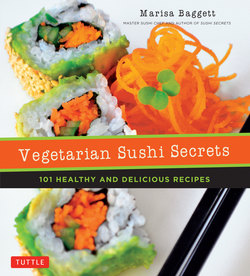Читать книгу Vegetarian Sushi Secrets - Marisa Baggett - Страница 6
На сайте Литреса книга снята с продажи.
ОглавлениеA Passion for Sushi
Foreword by Allison Day
Sushi has been a part of my life as long as I can remember. My family’s New Year’s Day tradition involved driving to the local Japanese restaurant to pick up a big order of sushi. For many years, this was the entire extent of my sushi experience.
Later, I started to slowly branch out with my sushi eating. The man I would go on to marry came up with the idea that I should start a food blog—all about sushi.
Because I was a college student on a budget, a restaurant review blog was out of the question. I decided to first teach my readers how to make sushi, and then come up with all sorts of creative recipes for sushi. It was through this mutual passion for less traditional takes on sushi that Marisa and I found each other several years ago.
With all this sushi making at home, it wasn’t long before I took over my family’s New Year’s sushi duty, making dozens of different rolls every New Year’s morning. Sushi became my go-to contribution to potlucks, which led to experimentation in meat- and fish-free rolls for my vegetarian friends. I’ve added tempura-fried and grilled vegetables to maki rolls, topped inari sushi with mushrooms, and even made a roll with hummus and bell peppers. While most people may automatically associate sushi with raw fish, I’ve found it to be an excellent format for vegetable-based rolls as well.
Over the years, all this sushi-making led to an interest in developing sushi recipes that even the most sushi-averse would enjoy, as well as a passion for sustainability in sushi. These interests are two very big reasons why I’m so excited for Vegetarian Sushi Secrets. Marisa and I share a passion for feeding people and showing them just how delicious sushi can be. And what better way to promote sustainability than to prove that sushi can be crave-worthy even in the absence of fish?
To have an entire cookbook full of delicious vegetarian options is beyond exciting for me. At first glance, I’m already making a mental list of all the recipes I want to try, and then introduce to my vegetarian friends.
If you’re new to sushi, the inari and nigiri section (page 58) is a great place to start. In Japan, inari is the kids’ meal of sushi, which means it’s great for beginners. (And to be honest, many people—including myself—remain big fans of inari sushi well into adulthood!) As for nigiri, it’s simply a ball of rice topped with something—in this case, vegetables or a slice of Japanese-style omelette. If you’re hesitant about the seaweed aspect, as many people are, this is a great way to ease yourself into the world of sushi.
For those more familiar with Americanized sushi rolls, Marisa has created tasty vegetarian versions of all your favorites. From Spider Rolls made with mushrooms to Dynamite Rolls with tofu, to Caterpillar Rolls with her Vegetarian Eel Sauce, and even a vegetarian version of the classic California Roll, the best-known American takes on sushi make a great vegetarian showing in this cookbook.
One of the things I love most about Marisa, as evidenced beautifully by both of her cookbooks, is that she isn’t afraid to get creative with sushi while still staying true to the traditional techniques and spirit. Whether you’re strictly vegan, wanting to eat more sustainably, or just trying to get more vegetables in your life, there’s something for everyone in this cookbook!
Allison Day
author of Sushi Day blog
